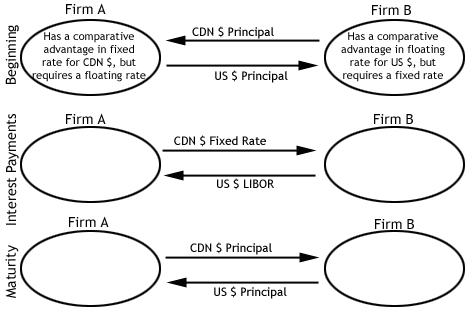CFA Level 1 - Derivatives
Like an interest rate swap, a currency swap is a contract to exchange cash flow streams from some fixed income obligations (for example, swapping payments from a fixed-rate loan for payments from a floating rate loan). In an interest rate swap, the cash flow streams are in the same currency, while in currency swaps, the cash flows are in different monetary denominations. Swap transactions are not usually disclosed on corporate balance sheets.
As we stated earlier, the cash flows from an interest rate swap occur on concurrent dates and are netted against one another. With a currency swap, the cash flows are in different currencies, so they can't net. Instead, full principal and interest payments are exchanged.
Currency swaps allow an institution to take leverage advantages it might enjoy in specific countries. For example, a highly-regarded German corporation with an excellent credit rating can likely issue euro-denominated bonds at an attractive rate. It can then swap those bonds into, say, Japanese yen at better terms than it could by going directly into the Japanese market where its name and credit rating may not be as advantageous.
At the origination of a swap agreement, the counterparties exchange notional principals in the two currencies. During the life of the swap, each party pays interest (in the currency of the principal received) to the other. At maturity, each makes a final exchange (at the same spot rate) of the initial principal amounts, thereby reversing the initial exchange. Generally, each party in the agreement has a comparative advantage over the other with respect to fixed or floating rates for a certain currency. A typical structure of a fixed-for-floating currency swap is as follows:
 |
Calculating the Payments on a Currency Swap
Let's consider an example:
Firm A can borrow Canadian currency at a rate of 10% or can borrow
Who has the comparative advantage?
To determine who has the comparative advantage, consider the fixed rates for each firm for the currency required. In this case, Firm A's rate of 10% is less than Firm B's rate of 11%, so Firm A has a comparative advantage in the fixed currency. That leaves Firm B to have a comparative advantage with respect to the floating rate.






0 comments:
Post a Comment